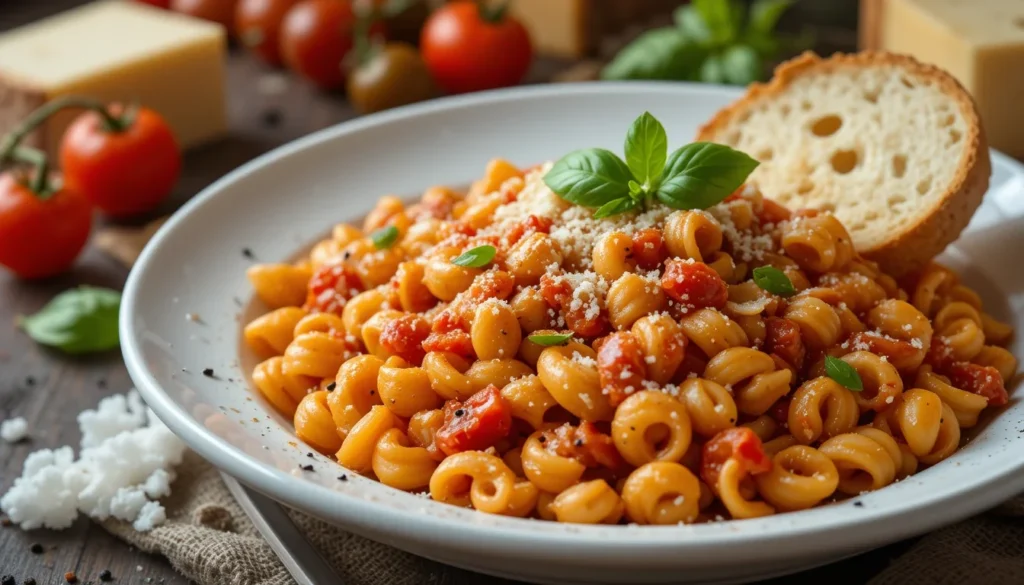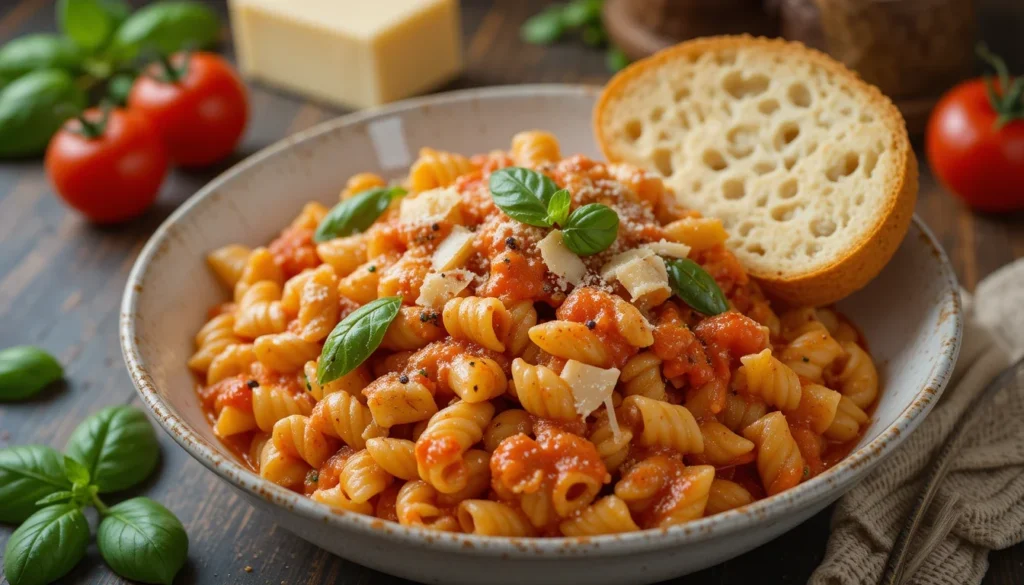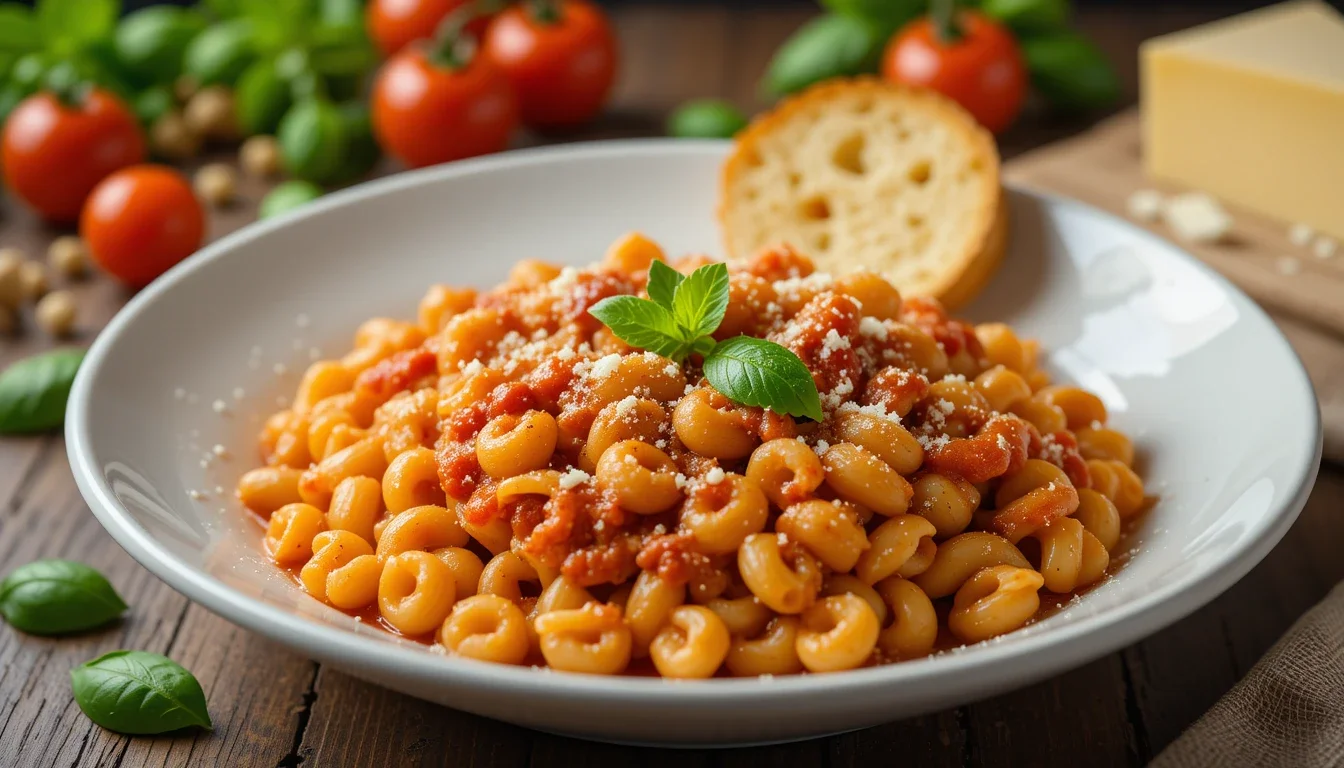Table of Contents
Ditalini pasta is a culinary gem, cherished for its versatility, distinctive shape, and ability to enhance a wide array of dishes. Known for its short, hollow tubes, this pasta variety has long been a staple in Italian kitchens, where it earned its place in comforting soups, stews, and hearty family meals. The name “ditalini,” which means “little thimbles” in Italian, is a nod to its unique form, perfectly designed to absorb and cling to sauces and broths.
Traditionally, ditalini pasta played a crucial role in rustic Italian cooking, particularly in recipes like Pasta e Fagioli and Minestrone. Its small size makes it ideal for evenly cooking alongside beans, vegetables, and proteins, creating dishes that are both satisfying and balanced. Over time, this humble pasta transcended its Italian roots, gaining global recognition for its adaptability to various cuisines and modern recipes.
Today, ditalini is celebrated for its ability to transition effortlessly between warm, hearty meals and light, refreshing options like pasta salads. Whether you’re preparing a traditional dish steeped in heritage or experimenting with contemporary flavors, ditalini offers a canvas for creativity in the kitchen.
In this article, we’ll dive into the history of ditalini, explore its many uses, provide expert tips for perfect preparation, and share delicious recipes that showcase why this pasta is beloved by home cooks and chefs alike.
What is Ditalini Pasta?
Ditalini pasta, meaning “little thimbles” in Italian, is a small, tube-shaped pasta that has become a beloved staple in kitchens worldwide. Originating from the sunny regions of Southern Italy, ditalini was traditionally used in humble, rustic dishes that showcased the ingenuity of Italian home cooks. Its compact, cylindrical shape not only made it economical—stretching a small amount of pasta to feed many—but also incredibly versatile, lending itself to a variety of hearty and satisfying meals.

What makes ditalini stand out is its ability to absorb and hold flavors, making it the perfect companion for brothy soups and stews. In iconic Italian dishes like Pasta e Fagioli or Minestrone, the pasta soaks up the savory goodness of the broth while maintaining its firm, al dente texture. Its shape is also ideal for blending seamlessly with ingredients like beans, vegetables, and meats, ensuring a cohesive bite in every spoonful.
Beyond soups, ditalini has found its way into modern recipes, including pasta salads, creamy casseroles, and even innovative fusion dishes. Its adaptability makes it a go-to choice for chefs and home cooks looking to create meals that are both comforting and satisfying. Whether you’re crafting a traditional Italian dish or experimenting with new flavors, ditalini pasta brings a unique texture and charm to the table.
The Unique Features of Ditalini Pasta
- Shape and Size: Ditalini’s compact, tube-like form makes it stand out among other pasta types.
- Texture: Its smooth exterior allows sauces and broths to cling effectively, enhancing every bite.
- Versatility: From traditional Italian fare to modern fusion dishes, ditalini excels in a variety of culinary applications.
What is Ditalini Pasta Used For
Ditalini is prized for its versatility in both traditional and contemporary recipes. Here are some common ways it’s used:
1. Soups and Stews
Ditalini pasta is a quintessential ingredient in classic Italian dishes like Pasta e Fagioli and Minestrone. Its small size ensures it cooks evenly alongside beans, vegetables, and meats, creating a harmonious blend of flavors and textures.
2. Cold Pasta Salads
In summer, ditalini shines in cold pasta salads, offering a delightful texture that holds up well under creamy or vinaigrette-based dressings. Add crunchy vegetables, fresh herbs, and proteins like chicken or shrimp for a complete meal.
3. Casseroles and Bakes
Ditalini is also perfect for cheesy pasta bakes and casseroles. Its hollow center allows it to trap melted cheese and sauces, delivering bursts of flavor with every bite.
For more traditional Italian recipes that feature ditalini, explore this guide for inspiration.
How to Cook Ditalini Pasta Perfectly
Achieving the perfect texture for ditalini pasta is essential for any dish. Here’s a foolproof guide to cooking it:
- Boil Water: Use a large pot with plenty of water and a pinch of salt. A good rule of thumb is one liter of water per 100 grams of pasta.
- Add Ditalini: Stir immediately to prevent the pasta from sticking together.
- Monitor Cooking Time: Cook for 8–10 minutes, tasting periodically to ensure it reaches an al dente texture.
- Drain and Serve: For hot dishes, serve immediately. For cold salads, rinse with cold water to stop the cooking process.
Tips for Perfect Ditalini Pasta
- Don’t overcook: Overcooking can cause ditalini to lose its shape and firmness.
- Pair it thoughtfully: Choose sauces and broths that complement the pasta’s size and texture.
- Add oil sparingly: If using ditalini in a salad, a drizzle of olive oil can help prevent clumping.
For expert pasta preparation advice, check out this pasta cooking guide.
Top Ditalini Pasta Recipes

Ditalini pasta’s versatility makes it the star of numerous recipes. Here are some tried-and-true dishes to explore:
1. Pasta e Fagioli
This iconic Italian soup combines ditalini with beans, tomatoes, and aromatic herbs. It’s a hearty, comforting dish that’s both nutritious and delicious.
2. Classic Minestrone
Packed with seasonal vegetables, this soup uses ditalini to add substance and texture. A generous sprinkle of Parmesan cheese on top makes it irresistible.
3. Cheesy Ditalini Bake
Layer ditalini with a blend of cheeses and marinara sauce, then bake until bubbly. This dish is a crowd-pleaser for potlucks or family dinners.
4. Ditalini Pasta Salad
Combine cooked ditalini with diced vegetables, olives, and a tangy vinaigrette for a refreshing side dish. For added protein, toss in grilled chicken or chickpeas.
5. Creamy Broccoli and Ditalini
A comforting weeknight dinner that pairs tender broccoli florets with ditalini in a creamy garlic sauce.
Each recipe showcases the unique qualities of ditalini, proving why it’s a favorite among home cooks and chefs alike.
Pairing Ditalini with Sauces and Ingredients
The beauty of ditalini lies in its ability to pair with a wide range of flavors. Here are some ideal combinations:
- Tomato-Based Sauces: Think hearty marinara or light, fresh pomodoro.
- Creamy Sauces: Alfredo, carbonara, or a simple garlic cream sauce.
- Herbs and Vegetables: Basil, parsley, spinach, zucchini, or bell peppers.
- Proteins: Ditalini works well with ground meats, shrimp, or shredded chicken.
Nutritional Benefits of Ditalini Pasta
Ditalini is not only delicious but also a source of important nutrients.
1. Rich in Carbohydrates
As a staple carbohydrate, ditalini provides sustained energy, making it a great choice for active individuals.
2. Fiber Content
Whole wheat ditalini offers additional fiber, which aids digestion and promotes satiety.
3. Gluten-Free Options
For those with dietary restrictions, many brands now offer gluten-free ditalini made from rice, quinoa, or corn.
For more details, check out these nutritional facts about pasta.
FAQs About Ditalini Pasta
What is the closest pasta to ditalini?
The closest pasta to ditalini includes small, tubular shapes like elbow macaroni or small shells. Other alternatives include mezzi rigatoni and pipette, which share similar structures suitable for soups and salads.
What kind of pasta is ditalini?
Ditalini is a type of short, tubular pasta. It belongs to the “small pasta” category and is often used in Italian soups like Pasta e Fagioli and Minestrone.
How do you pronounce the name ditalini?
Ditalini is pronounced as dee-tah-LEE-nee, with emphasis on the second syllable.
Is ditalini pasta the same as macaroni?
Ditalini and macaroni are similar in that they are both short, tube-shaped pastas. However, ditalini is smaller and has straighter edges compared to the slightly curved shape of macaroni.
Is ditalini the same as orzo?
No, ditalini and orzo are different. Orzo is shaped like a large grain of rice, while ditalini is a short tube. They serve different purposes in recipes but can sometimes be substituted in soups or salads.
What is the best pasta for Ragu?
The best pasta for a rich ragu sauce is typically tagliatelle, pappardelle, or fettuccine, as their wide, flat shapes hold onto the meat sauce better. Ditalini is not traditionally paired with ragu but can be used in a baked casserole with a ragu base.
Is ditalini similar to pastina?
Ditalini is larger than pastina, which consists of tiny, star-like pasta pieces. While both are ideal for soups, ditalini provides a firmer bite and is better suited for hearty recipes.
What is healthier than orzo?
For a healthier alternative to orzo, consider quinoa, farro, or barley. These grains are high in fiber and protein, offering more nutritional benefits.
What is orzo called in Italy?
In Italy, orzo is often referred to as risoni, which translates to “big rice,” due to its rice-like shape.
Conclusion
Whether you’re recreating classic Italian dishes or experimenting with modern recipes, ditalini pasta is a fantastic choice. Its small, tubular shape makes it perfect for soups, salads, and baked dishes, while its nutritional value adds to its appeal. If you’re planning a dinner party, pair your pasta dishes with something delightful like these smoked chicken drumsticks for a hearty main course. Alternatively, complement your pasta salad with a tangy, sweet addition such as this pineapple casserole.
Explore this versatile pasta, along with other innovative recipes like the classic taco dip, and bring authentic Italian flavors to your table


6 thoughts on “Discover the Versatility of Ditalini Pasta: Recipes, Tips & More”